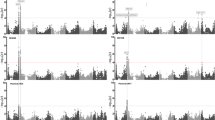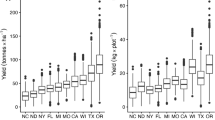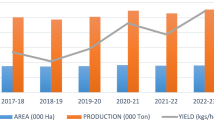Summary
Selection for yield under spaced plant conditions was carried out for three generations in five lines of Lolium perenne derived from natural populations and of known genetic organisation, and for two generations from within the bred variety S.23. Evaluation of all selected generations under comparable spacing conditions revealed that overall a slow positive response to selection had been achieved. The magnitude and direction differed for the several lines and was inconsistent. The variable response was accounted for by low heritability, genotype x year interaction and the small population size with high intensity of selection imposed.
Similar content being viewed by others
References
Breese E. L., 1966. Aims in herbage breeding. Outlook on Agriculture 5: 110–116.
Breese E. L., 1969: The measurement and significance of genotype-environment interactions in grasses. Heredity 24: 27–44.
Breese E. L. & M. D. Hayward, 1972. The genetic basis of present breeding methods in forage crops. Euphytica 21: 326–336.
Burton G. W., 1974. Recurrent restricted phenotypic selection increases yield of Pensacola Bahia grass. Crop Sci. 14: 831–835.
Cooper J. P., 1959. Selection and population structure in Lolium. III. Selection for date of ear emergence. Heredity 13: 461–479.
Cooper J. P. & K. J. R. Edwards, 1961. Genetic control of leaf development in Lolium. I. Assessment of genetic variation. Heredity 16: 63–82.
Edwards K. J. R. & J. P. Cooper, 1963. Genetic control of leaf development in Lolium. I. Response to selection. Heredity 18: 307–317.
England F. W., 1975. Heritabilities and genetic correlations for yield in Italian ryegrass (Lolium multiflorum Lam.) grown at different densities. J. Agric. Sci., Camb. 84: 153–158.
Fejer S. O., 1960. Selection for high and low productivity in perennial ryegrass (Lolium perenne L.). I. Heritability studies of early generations. N.Z.J. Agric. Res. 3: 764–771.
Hayward M. D. & E. L. Breese, 1966. The genetic organization of natural populations of Lolium perenne L. I. Seed and seedling characters. Heredity 21: 287–304.
Hayward M. D. & E. L. Breese, 1968. The genetic organisation of natural populations of Lolium perenne. III. Productivity. Heredity 23: 357–368.
Hayward M. D. & T. Lawrence, 1970. Genetic control of variation in a selected population of Lolium perenne L. Can. Genet. Cytol. 12: 806–815.
Hayward M. D. & G. F. Nsowah, 1969. The genetic organisation of natural populations of Lolium perenne L. IV. Variation within populations. Heredity 24: 521–528.
Lazenby A. & H. H. Rogers, 1962. Selection criteria in grass breeding. I. J. Agric. Sci., Camb. 59: 51–62.
Lazenby A. & H. H. Rogers, 1964. Selection criteria in grass breeding. II. Effect on Lolium perenne of differences in population density, variety and available moisture. J. Agric. Sci., Camb. 62: 285–298.
Perkins J. M. & J. L. Jinks, 1968a. Environmental and genotype-environmental components of variability. III. Multiple lines and crosses. Heredity 23: 339–356.
Perkins J. M. & J. L. Jinks, 1968b. Environmental and genotype-environmental components of variability. IV. Non-linear interactions for multiple inbred lines. Heredity 23: 525–535.
Rhodes I., 1973. Relationship between canopy structure and productivity in herbage grasses and its implications for plant breeding. Herb. Abstr. 43- 129–133.
Robson D. S., Leroy Powers & N. S. Urquhart, 1967. The proportion of genetic deviates in the tails of a normal distribution. Der Züchter 37: 205–216.
Samuel C. J. A., J. Hill, E. L. Breese & Alison Davies, 1970. Assessing and predicting environmental response in Lolium perenne. J. Agric. Sci., Camb. 75: 1–9.
Sedcole J. R. & R. J. Clements, 1973. Studies on genotype x spacing interactions for herbage yield using a modified diallel analysis. J. Agric. Sci., Camb. 80: 97–104.
Thompson, A. J. & A. J. Wright, 1972. Principles and problems in grass breeding. Rep. Pl. Breed. Inst., Camb. for 1971, pp. 31–67.
Van Bogaert G., 1977. Scope for improving the yield of grasses and legumes by breeding and selection. Proceedings of the International Meeting on Animal Production from Temperate Grassland, Dublin 1977 (Ed. B. Gilsenan). An Foras Taluntais, Dublin, pp. 29–35.
Van Dijk G. E. & G. D. Winkelhorst, 1978. Testing perennial ryegrass (Lolium perenne L.) as spaced plants in swards. Euphytica 27: 855–860.
Wilson, D., 1976. Physiological and morphological selection criteria in grasses. In: Breeding methods and variety testing in forage plants. Report of Eucarpia Fodder Crops Section Meeting (Ed. B. Dennis). Roskilde, Denmark, pp. 9–18.
Author information
Authors and Affiliations
Rights and permissions
About this article
Cite this article
Hayward, M.D. Selection for yield in Lolium perenne. I. Selection and performance under spaced plant conditions. Euphytica 32, 85–95 (1983). https://doi.org/10.1007/BF00036867
Received:
Issue Date:
DOI: https://doi.org/10.1007/BF00036867




